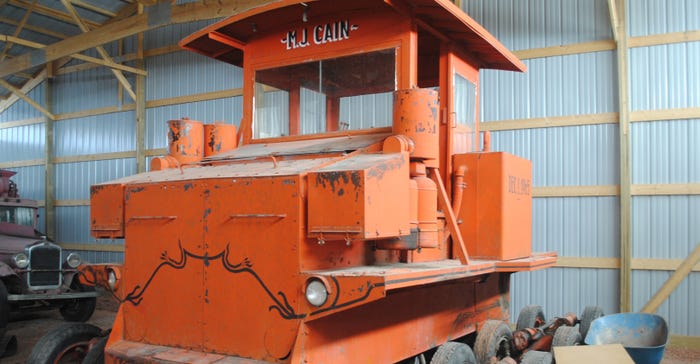
Nebraska is a diverse agricultural state, with a broad farming and ranching history. Some of the state’s finest ag history museums and educational sites help to tell the story of Nebraska agriculture through time.
In our series of Nebraska Farmer virtual tours, we encourage teachers, ag students, 4-H and FFA members, farmers and ranchers, and ag history enthusiasts to enjoy some of the state’s unique ag history sites through the camera lens of NF.
This week, we travel to the Pine Ridge to tour the unique Marcus Cain Exhibit Building at the Dawes County Historical Society Museum, just south of Chadron, Neb.
Cain exhibit at Dawes County Historical Society Museum
Marcus Cain was one of a kind. The longtime Dawes County farmer held only one patent, obtained in 1927, but over the course of his farming career, he designed and built dozens of new, unpatented inventions to make farming easier.
He farmed up to 4,000 acres of potatoes and wheat in Dawes County. He had an oil and gas refinery on his farm south of Chadron, Neb. Cain was friends with such agriculture manufacturing legends as the Baldwin brothers, who developed the first Gleaner combines.
He had offers to work for some of the largest farm machinery manufacturers of his day — and turned them down. Cain was a Dawes County farmer, first and foremost, although his career as an inventor came in a close second.
When he retired in 1971, he sold his farm to Pat and Jackie Cullan and moved to California. Cain had the wish that his unique collection of homemade equipment would one day grace the halls of an agricultural museum.
“He always wanted the machinery to be preserved somewhere,” Pat Cullan told Nebraska Farmer when we visited their farm in fall 2015. Pat and Jackie’s son, Shane, told us that he loved growing up with all of Cain’s equipment stored around the Cullan farmstead. But the goal of moving those historic pieces to the DCHS museum in Chadron was always on the family’s radar.
Although Cain died in California in 1979, that opportunity finally came in 2016, when the Cullan family donated Cain’s machinery to the DCHS museum, and a new Cain Exhibit Building was constructed to house and interpret the historic implements for future generations.
We were there along this journey. Thanks to the hospitality of the Cullans, we were able to learn about the machinery stored at the Cullan farm before the implements were moved to the museum, and were invited to visit the farm where Cain invented his unique machines.
Months later, we visited the exhibit at the DCHS museum just after the displays officially opened for the public, so we could chronicle the legacy of Cain and his inventive genius. As former DCHS president Bernie Cripps of Whitney put it, “These pieces are not only important to Dawes County, but they are historically significant to the agricultural development of the Midwest.” Cripps noted in his interviews that Cain’s inventions were futuristic and forward-thinking, to say the least.
Some of Cain’s inventions already have disappeared. A gigantic articulated tractor with a front and rear engine was moved to a museum collection outside the region years ago. Cain’s prototype self-propelled combine, which was considered the first of its kind in the nation, was dismantled for parts before the Cullans moved onto the Cain land. That’s part of the reason the remaining implements have become so important to the residents of Dawes County.
One of the Cain exhibit pieces that was stored on the Cullan land for many years and moved into the new museum exhibit hall was a 200-hp tractor that Cain built from a World War II tank retriever. The original retriever unit had tracks, but Cain found that the tracked vehicle tore up the light soil when he turned around on the ends of his fields, so he came up with a new drive system.
Built in 1965, the machine was painted in Cain’s signature orange color, with the name “M. J. Cain” painted on the cab. Cain built a 20-foot stubble chopper to reduce crop residue and make a better seedbed for drilling, long before no-till was widely practiced.
He invented a 24-foot combination self-propelled tiller, drill and packer with track drive and three engines — named for Cain’s daughter — complete with rear field lights, which were considered innovative at the time.
All these pieces and others are now exhibited and interpreted in a new 80-foot-by-60-foot Cullan-Littrel metal building on the grounds of the impressive DCHS museum. The effort to bring the pieces to the museum was an entire community campaign, with local donations helping to bring the collection to Chadron for display.
Join us for a virtual tour of the unique, one-of-a-kind Cain exhibit at Chadron that in many ways honors not only Cain, but also farmer-inventors across Nebraska and the High Plains and Great Plains region.
Learn more on the Dawes County Historical Society Museum Facebook page or by calling the museum at 308-432-4999.
About the Author(s)
You May Also Like






